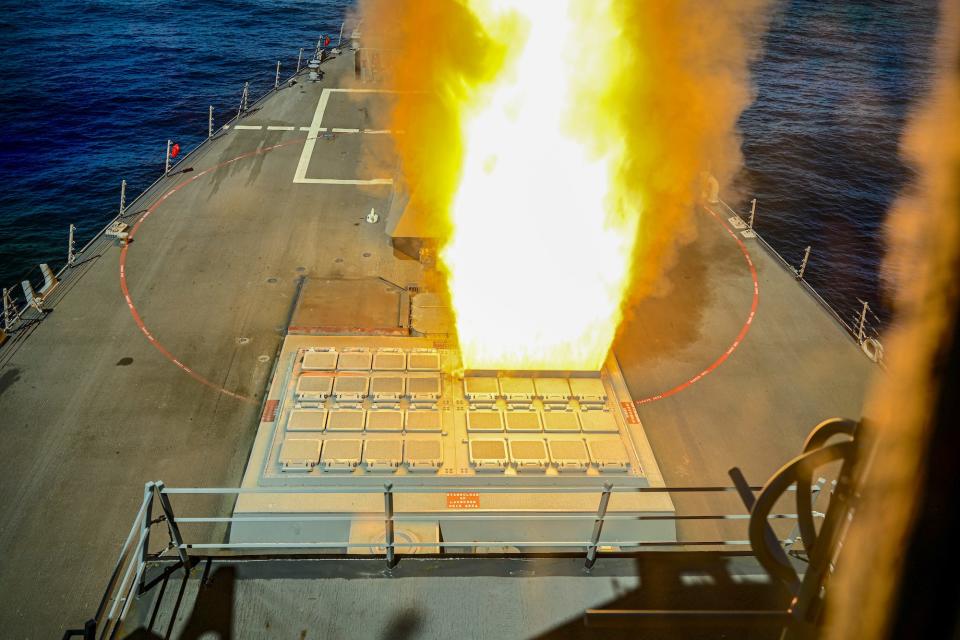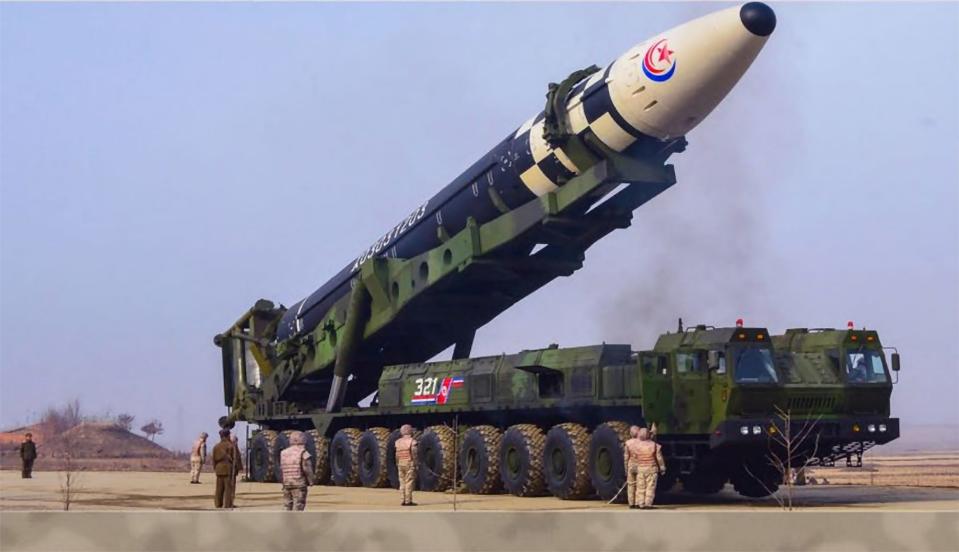South Korea is working on an 'arsenal ship' in case it has to shower North Korea with missiles



-
The South Korean navy is pursuing what it calls the "Joint Firepower Ship."
-
Borrowing a US concept, the so-called arsenal ship is meant to carry dozens of missiles.
-
If built, it would be a central part of Seoul's defense against a North Korean nuclear attack.
In June, South Korean shipbuilder Hanwha Ocean showcased a model of its "arsenal ship" design at the International Maritime Defense Industry Exhibition in Busan.
It was the latest sign of progress on an ambitious project for which the South Korean navy has notably given few updates on, or specific details about, over the years.
South Korea's Ministry of National Defense announced the project in 2019 to acquire up to three arsenal ships and make them a central part of its navy's role in the "Three-Axis" System, which is Seoul's strategy to defend against North Korea's nuclear weapons and ballistic missiles.
If completed, they would be the first arsenal ships ever built and would mark another accomplishment for South Korea's burgeoning defense industry. The arsenal ship concept itself, however, is the brainchild of the US Navy.
The arsenal ship

Proposed in 1996, the arsenal ship was one of the US Navy's first proposed adaptations to the post-Cold War threat environment.
With the Soviet Union gone and the Russian Navy a shell of its forbear's strength, there was little need for a large fleet dedicated to battling a first-rate adversary on the high seas. Instead, most threats were ground-based and either close to shore or farther inland.
Consequently, the US Navy reduced the number of ships in its inventory and focused on developing long-range strike capability for use in joint operations with other military branches.
To maximize its role in this new era, the Navy proposed a completely new type of warship: A massive, stealthy, highly automated vessel — requiring a crew of no more than 50 — armed with hundreds of missiles capable of strikes on strategic targets, strikes deep inside enemy territory, fire support, and air and ballistic-missile defense.
Dubbed the "arsenal ship," it would have up to 500 Vertical Launch System cells — more than any other ship in the fleet — capable of launching Tomahawk land-attack cruise missiles, SM-2 interceptor missiles, and RIM-162 Evolved Sea Sparrow missiles.

The Navy also wanted the ships to carry naval variants of the Hawk surface-to-air missile, the MGM-140 Army Tactical Missile System, the Standoff Land-Attack Missile, and a land-attack variant of the Navy's Standard Missile.
To increase their interoperability, the arsenal ships were to have a fire-control capability that could be operated remotely by AEGIS-equipped vessels nearby, by Air Force AWACS and JSTARS aircraft, or even by ground units.
The Navy described the arsenal ship as the "battleship of the 21st century" and a "remote missile and fire support magazine" and wanted to build six that it would assign to three two-ship squadrons.
The service argued that the ship's massive armament could substitute for long-range ground- and carrier-based airstrikes, and that the ships would obviate the need to base aircraft or missiles overseas and maintain large logistical networks to supply them.
Despite the Navy's ambitions, the arsenal ship was deemed to be too much of a target, given its limited self-defense capability, and unneeded, since the cruisers and destroyers that would escort it each had roughly 100 VLS cells already. Detractors also noted that it didn't make much sense to build a stealthy ship that needed to be accompanied by non-stealthy escorts.
Consequently, the arsenal ship concept was ultimately abandoned.
South Korean interest

South Korea's interest in arsenal ships stems from its need for guaranteed strike capability against hardened North Korean targets.
Given the North's nuclear arsenal — estimated at several dozen to roughly 100 warheads — South Korea is concerned that most or even all of its major military bases and command centers could be destroyed in nuclear blasts before it could mount an effective defense. That fear is deepened by Pyongyang's ongoing work on longer-range and submarine-launched missiles.
That makes a remote, mobile missile and fire-support magazine a useful asset, as it would ensure that South Korea would have missiles to strike North Korea should its land-based systems be destroyed. It would also support the South Korean navy's role in the "Three-Axis" System, a strategy to preempt or respond to a North Korean nuclear attack.
The axes comprise "Kill Chain," a preemptive strike against North Korea's nuclear weapons and ballistic missiles; "Korea Air and Missile Defense," a network of layered missile-defense systems to intercept North Korean missiles; and "Korea Massive Punishment and Retaliation," an effort to attack North Korean leadership by destroying their hardened bunkers and command centers.
Given the number and types of missiles South Korea's arsenal ships would carry, they could be involved in all three axes — all while staying mobile.
Hanwha Ocean's arsenal ship
Few details about South Korea's arsenal ship program have been released. What is known is that its navy wants up to three ships that would each carry at least 80 missiles and likely displace at least 5,000 tons.
The South Korean navy in April selected Hanwha Ocean — at the time still known as Daewoo Shipbuilding and Marine Engineering — to design the concept for what Seoul has called the "Joint Firepower Ship."
In June, the company showed off its concept for the first time, which it called the "Joint Strike Ship." Based on its earlier KDDX destroyer design, the full-size version would measure nearly 500 feet long, displace about 8,000 tons, and be able to carry at least 100 missiles of various types.
The forward section of the ship contains 48 KVLS-I cells, which are likely to carry surface-to-air missiles. Another 32 KVLS-II cells, which would likely hold Haeseong II cruise missiles or L-SAM interceptors, are located right behind the mast. Behind them are 15 amidship launch tubes for ballistic missiles.
The concept model also has three launchers for larger ballistic missiles at the rear of the ship. Two erectable dual-launchers are forward of the helicopter deck and a single launcher for a larger missile is aft, raised over the stern. A Hanwha Ocean engineer told Naval News that a supply vessel would be needed to load the ballistic missiles at sea.

Naval variants of the Hyunmoo 4 ballistic missile are likely to be used in the amidship launch tubes, while the two erectable double launchers are expected to be used with the Hyunmoo 5.
In development since 2020, the Hyunmoo 4 is believed to have a 2-ton warhead and a range of 500 miles. The new Hyunmoo 5 is capable of carrying a 1-ton warhead some 1,800 miles or an 8- to 9-ton warhead about 180 miles.
The Hyunmoo 5 is designed specifically for destroying North Korea's extensive bunker and underground fortification network, making it a central part of the KMPR axis. It is reportedly capable of reaching Mach 10 during its descent and of destroying structures roughly 330 feet underground.
Unlike the proposed US arsenal ship, Hanwha Ocean's concept has several defensive armaments, including a CIWS-II at the bow and at the stern for defense against missiles and aircraft, two chaff decoy launchers, and two anti-torpedo decoy launchers.
Hanwha Ocean has said that it will complete and present the Required Operational Capability for its arsenal ship design by the end of December, meaning the final product could be different from the model shown in June.
As in the US, some in South Korea are skeptical of the arsenal ship's utility, but there is little doubt that it can be built. South Korea is one of the world's leading shipbuilders and is already building large, well-armed warships for its navy and for export.
- Questions and Answers
- Opinion
- Story/Motivational/Inspiring
- Technology
- Art
- Causes
- Crafts
- Dance
- Drinks
- Film/Movie
- Fitness
- Food
- Spiele
- Gardening
- Health
- Home
- Literature
- Music
- Networking
- Other
- Party
- Religion
- Shopping
- Sports
- Theater
- Wellness
- News
- Culture
- War machines and policy

